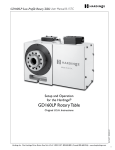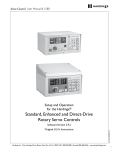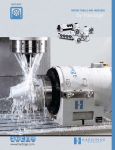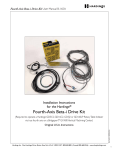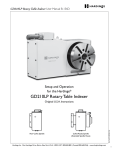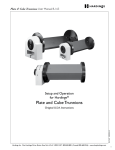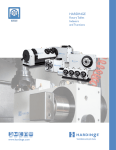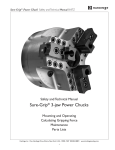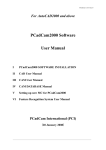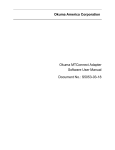Download User Manual, GD5C2 Rotary Indexer
Transcript
GD5C2 Rotary Indexing System User Manual B-119J Setup and Operation for the Hardinge® GD5C2 Rotary Indexing System Part No. BJ -0009500-0119 Original U.S.A. Instructions Hardinge Inc. One Hardinge Drive, Elmira, New York U.S.A. 14902-1507 800.843.8801 (Canada 800.468.5946) www.shophardinge.com 1 GD5C2 Rotary Indexing System User Manual B-119J Thank you for purchasing a Hardinge GD5C2 Rotary Indexing System! This User’s Manual is provided to assist you with setup procedures and to familiarize you with the features, specifications and maintenance recommendations of your unit. The mechanical indexing head can be maintained by the customer with proper cleaning, lubrication, and maintenance. Any necessary repairs required during the warranty period will be made at Hardinge Inc. or by a factory authorized representative. Hardinge supplies a complete array of 5C workholding products including collets, step chucks, expanding collets, chucks and fixture plates. Custom manufacturing is also available. Hardinge Inc. One Hardinge Drive Elmira, New York 14902-1507 U.S.A p. 800.843.8801 p. 800.468.5946 (Canada) f. 607.734.3886 Part No. BJ -0009500-0119 2 Hardinge Inc. One Hardinge Drive, Elmira, New York U.S.A. 14902-1507 800.843.8801 (Canada 800.468.5946) www.shophardinge.com GD5C2 Rotary Indexing System User Manual B-119J Table of Contents Important Safety Recommendations............................................................................................... 4 1. Introduction..................................................................................................................................... 7 1.1Description..................................................................................................................... 7 1.2 High Stiffness Overall System..................................................................................... 7 1.3 Machinable Part Size..................................................................................................... 7 1.4Features........................................................................................................................... 8 1.5 Specifications and General Requirements............................................................... 9 1.6Dimensions................................................................................................................... 10 2. Set Up 2.1 General Setup............................................................................................................... 12 2.2 Use of Collets, Chucks and Face Plates.................................................................. 14 2.3 Hardinge Fail-Safe and High-Force Closers........................................................... 14 2.4 Use of Collets with the Hardinge Collet Closer................................................. 15 2.5 Replacing Collet Closers........................................................................................... 16 2.6 Tooling Locations......................................................................................................... 29 3. Backlash Adjustment 3.1 Measuring Backlash..................................................................................................... 19 3.2 Adjusting Backlash....................................................................................................... 21 4. Routine Maintenance 4.1 Use of Oil- and Water-Soluble Coolants................................................................ 22 4.2Lubrication.................................................................................................................... 22 4.2.1 Lubrication of Multi-Spindle Units................................................................. 23 4.3 Collet Key Replacement............................................................................................ 26 4.4 Clean Up........................................................................................................................ 26 Part No. BJ -0009500-0119 5. Warranty......................................................................................................................................... 26 Hardinge Inc. One Hardinge Drive, Elmira, New York U.S.A. 14902-1507 800.843.8801 (Canada 800.468.5946) www.shophardinge.com 3 GD5C2 Rotary Indexing System User Manual B-119J Safety Recommendations READ COMPLETE INSTRUCTIONS CAREFULLY BEFORE OPERATING THIS UNIT. Note: Equipment refers to the indexing system and/or machine it is used with. When this instruction book was printed, the information given was current. However, since we are constantly improving the design of our products, it is possible that the illustrations and descriptions may vary from the system you receive. - WARNING Occupational Safety and Health Administration (OSHA) Hazard Communication Standard 1910.1200, effective May 25, 1986, and various state "employee right-to-know laws" require that information regarding chemicals used with this equipment be supplied to you. Refer to the applicable section of the Material Safety Data Sheets supplied with your unit when handling, storing or disposing of chemicals. HARDINGE SAFETY RECOMMENDATIONS Your Hardinge machine is designed and built for maximum ease and safety of operation. However, some previously accepted shop practices may not reflect current safety regulations and procedures and should be re-examined to insure compliance with the current safety and health standards. Hardinge Inc. recommends that all shop supervisors, maintenance personnel, and machine tool operators be advised of the importance of safe maintenance, setup and operation of Hardinge-built equipment. Our recommendations are described below. READ THESE SAFETY RECOMMENDATIONS BEFORE PROCEEDING ANY FURTHER. READ THE APPROPRIATE MANUAL OR INSTRUCTIONS before attempting operation or maintenance of the equipment. Make certain that you understand all instructions. DO NOT ALLOW the operation or repair of equipment by untrained personnel. CONSULT YOUR SUPERVISOR when in doubt as to the correct way to do a job. WEAR SAFETY GLASSES AND PROPER FOOT PROTECTION at all times. When necessary, wear respirator, helmet, gloves and ear muffs or plugs. DON’T OPERATE EQUIPMENT unless proper maintenance has been regularly performed and the equipment is known to be in good working order. WARNING or INSTRUCTION TAGS are mounted on the unit for your safety and information. Do not remove them or damage them. DO NOT ALTER THE EQUIPMENT to bypass any interlock, overload, disconnect, or other safety device. DO NOT OPERATE EQUIPMENT if unusual or excessive heat, noise, smoke or vibration occurs. Report any excessive or unusual vibration, sounds, smoke, or heat as well as any damaged parts. LIFTING AND HANDLING OF THE UNIT should be done with full knowledge of the unit weight and using proper procedures. MAKE CERTAIN that the equipment is properly grounded. Consult National Electric Code and all local codes. Remove power from the unit by unplugging the power cord before attempting repair or maintenance. (Where Applicable) DON’T OPEN THE CONTROL BOX without consulting with Hardinge. (Where Applicable) REPLACE BLOWN FUSES with fuses of the same size and type as originally furnished. (Where Applicable) ASCERTAIN AND CORRECT the cause of a shutdown caused by overload heaters before restarting the machine. (Where Applicable) KEEP THE AREA AROUND THE MACHINE well lit and dry. 4 Hardinge Inc. One Hardinge Drive, Elmira, New York U.S.A. 14902-1507 800.843.8801 (Canada 800.468.5946) www.shophardinge.com Part No. BJ -0009500-0119 DON’T TOUCH ELECTRICAL EQUIPMENT when hands are wet or when standing on a wet surface. (Where Applicable) GD5C2 Rotary Indexing System User Manual B-119J Safety Recommendations (continued) KEEP CHEMICAL AND FLAMMABLE MATERIAL away from electrical or operating equipment. HAVE THE CORRECT TYPE OF FIRE EXTINGUISHER handy when machining combustible material and keep chips clear of the work area. DON’T USE a toxic or flammable substance as a solvent cleaner or coolant. MAKE CERTAIN THAT PROPER GUARDING is in place and that all doors to the primary machine are closed and secured. DON’T OPEN GUARD DOORS of the primary machine while any machine component is in motion. MAKE SURE chucks, closers, fixture plates and all other spindle-mounted workholding devices are properly mounted and secured before starting the unit or the machine. MAKE CERTAIN all tools are securely clamped in position before starting the unit or the machine. REMOVE ANY LOOSE PARTS OR TOOLS left on the unit or the machine or in the work area before operating the equipment. Always check the machine and work area for loose tools and parts especially after work has been completed by maintenance personnel. REMOVE CHUCK WRENCHES before starting the unit or the machine. BEFORE PRESSING THE CYCLE START PUSH BUTTON, make certain that proper functions are programmed and that all controls are set in the desired modes. KNOW WHERE ALL stop push buttons are located in case of an emergency. CHECK THE LUBRICATION OIL LEVEL before operating the machine. MAKE CERTAIN that all guards are in good condition and are functioning properly before operating the equipment. INSPECT ALL SAFETY DEVICES AND GUARDS to make certain that they are in good condition and are functioning properly before the cycle is started. CHECK THE POSITION of any load/unload automation before pressing the Cycle Start push button. CHECK SETUP, TOOLING, AND SECURITY OF THE WORKPIECE if the machine has been OFF for any length of time. DRY CYCLE a new setup to check for programming errors. MAKE CERTAIN that you are clear of any "pinch point" created by moving slides before starting the machine. DON’T OPERATE any equipment while any part of the body is in the proximity of a potentially hazardous area. DON’T REMOVE CHIPS with hands. Use a hook or similar device and make certain that all machine movements have ceased. BE CAREFUL of sharp edges when handling a newly machined workpiece. DON’T REMOVE OR LOAD a workpiece while any part of the equipment is in motion. DON’T OPERATE ANY EQUIPMENT while wearing rings, watches, jewelry, loose clothing, neckties or long hair not contained by a net or shop cap. DON’T ADJUST tooling or coolant hoses while the equipment is running. DON’T LEAVE tools, workpieces or other loose items where they can come in contact with a moving component of the equipment. DON’T JOG SPINDLE in either direction when checking threads with a thread gage. DON’T ATTEMPT to brake or slow the equipment with hands or any makeshift device. ANY ATTACHMENT, TOOL OR MACHINE MODIFICATION not obtained from Hardinge Inc. must be reviewed by a qualified safety engineer before installation. Hardinge Inc. One Hardinge Drive, Elmira, New York U.S.A. 14902-1507 800.843.8801 (Canada 800.468.5946) www.shophardinge.com Part No. BJ -0009500-0119 DON’T CHECK finishes or dimensions of workpiece near running spindle or moving slides. 5 GD5C2 Rotary Indexing System User Manual B-119J Safety Recommendations (continued) USE CAUTION around exposed mechanisms and tooling especially when setting up. Be careful of sharp edges on tools. DON’T USE worn or defective hand tools. Use the proper size and type for the job being performed. USE ONLY a soft-faced hammer on tooling and fixtures. DON’T USE worn or broken tooling on machine. MAKE CERTAIN that all tool mounting surfaces are clean before mounting tools. INSPECT ALL CHUCKING DEVICES daily to make certain that they are in good operating condition. Replace any defective chuck before operating the machine. USE MAXIMUM ALLOWABLE gripping pressure on the chuck. Consider weight, shape, and balance of the workpiece. DON’T EXCEED the rated capacity of the equipment. DON’T LEAVE the equipment unattended while it is operating. DON’T CLEAN the equipment with an air hose. KEEP TOTE PANS a safe distance from the machine. Don’t overfill the tote pans. DON’T LET STOCK project past the back end of the collet closer or equipment spindle without being adequately covered and properly supported. UNLESS OTHERWISE NOTED, all operating and maintenance procedures are to be performed by one person. To avoid injury to yourself and others, be sure that all personnel are clear of the equipment when opening or closing the coolant guard door and any access covers. FOR YOUR PROTECTION - WORK SAFELY DON’T OPERATE THE EQUIPMENT with damaged or worn electrical cables. Part No. BJ -0009500-0119 VERIFY that the electrical cables are not restrained or pinched during full travel movement of the machine. 6 Hardinge Inc. One Hardinge Drive, Elmira, New York U.S.A. 14902-1507 800.843.8801 (Canada 800.468.5946) www.shophardinge.com GD5C2 Rotary Indexing System User Manual B-119J 1. Introduction 1.1 Description For accurate and dependable positioning of small parts in machining operations such as milling, drilling, tapping, contouring and spiral milling. The Hardinge® GD5C2 Rotary Indexing System is a fully integratable, programmable rotary positioning device that saves on workspace without sacrificing performance. The mechanical indexing head holds the workpiece, which is positioned by programming angular movements into the all-digital servo control as a slave to a CNC machine or directly into a CNC control in a true 4th-axis setup. The mechanical indexing head features a threaded spindle nose for spindle tooling compatibility with other 5C spindle CNC lathes. The mechanical Indexing head is configured to run in the horizontal position. If a vertical running position is required (spindle pointing up), you must make alterations to the motor cover that are detailed as follows: Located on the bottom of the motor cover when the indexer is in the horizontal position (spindle pointing right or left), are two drain holes. If the indexer is to be mounted vertically, drill and tap these holes for M5 set screws. Seal the holes using M5 set screws and thread sealant. Drill and tap a hole for a M5 set screw on the side of the motor cover parallel with the back mounting face of the indexer. This will be the new drain hole for the indexer when it is mounted vertically. If the indexer orientation is changed to horizontal mounting, remove the two set screws and place one in the vertical mounting drain hole. If this procedure is not followed, the warranty will be void for any contamination in the motor cover. THE 5C DUAL, TRIPLE AND QUAD UNITS CAN BE RUN IN THE HORIZONTAL POSITION ONLY. The GD5C2 Rotary Indexing spindle is based on the industry standard threaded spindle design that has been used in Hardinge lathe production for over a century. The Hardinge-engineered mechanical elements guarantee the spindle will be accurate, repeatable, reliable, and flexible to suit many different machining applications. The spindle carries a centerline from the machine bed of 4.00"/101.6mm, which is compatible with many other indexing products. The spindle is hardened and ground for accuracy and has a rigid design with dual tapered roller bearings to support heavy cutting forces. Positioning of the spindle is accomplished through a self-locking gear set. 1.2 High Stiffness Overall System The Hardinge GD5C2 Rotary Indexing System uses a high quality hardened gear system with a 60:1 ratio. This type of gearing allows for an efficient forward driving capability (motor side through the worm) while at the same time preventing back driving from occurring by the applied cutting forces at the spindle side. This is an important operating characteristic of the high ratio gear system since it adds stiffness into the machining operation. Stiffness or rigidity is one of the more important features of any system employed in the activity of machining operations and is the driving force for Hardinge-engineered rotary systems. The Hardinge Indexer provides the stiffness for the toughest applications through the spindle hard bearings, the non-backdriving worm gearing, the servo holding mechanism, and the stiffness of the 5C workholding system. 1.3 Machinable Part Size Larger part sizes than those described above can be handled with certain restrictions and should not exceed 50lb/22.7kg in weight. Hardinge Inc. One Hardinge Drive, Elmira, New York U.S.A. 14902-1507 800.843.8801 (Canada 800.468.5946) www.shophardinge.com Part No. BJ -0009500-0119 The Hardinge GD5C2 Rotary Indexing System has been designed for those parts that can be conveniently gripped in any of the 5C gripping systems that Hardinge is noted for. Typical parts are in the range of approximately 2"/50.8mm in diameter, and generally not longer than 6"/152.4mm without the use of a tailstock. It is typical to speak in terms of the L/D (Length/Diameter) ratio, which is the length divided by the part diameter. A 2" diameter part 6" long has an L/D ratio of 3:1. Part pieces with larger L/D ratios should be used with a tailstock up to a typical L/D ratio of 6:1. 7 GD5C2 Rotary Indexing System User Manual B-119J 1.4 Features RIGID DESIGN – Increased distance between large bearings support heavy cutting forces on large or small parts HARDENED AND GROUND SPINDLE for higher accuracy DUAL TAPERED ROLLER BEARINGS support heavy cutting forces AUTOMATIC CIRCLE DIVISION (With Hardinge Servo Control) You can program a step that automatically divides a circle into any number of equal parts between 2 and 999 STOP/FEED-HOLD (With Hardinge Servo Control) You can use the STOP to feed-hold spindle movement without losing position on restart FAST SETUPS (With Hardinge Servo Control) All connectors are "quick-disconnect", ensuring fast and easy setups INTERFACING (With Hardinge Servo Control) Most CNC mills can be interfaced quickly and easily by using a spare "M" function which provides a switch-closer as a signal between your mill and the control LINEAR & SPIRAL MILLING (With Hardinge Servo Control)for semi fourth-axis capability MEMORY (With Hardinge Servo Control) A nonvolatile memory retains your program even when power is turned OFF and remembers the current spindle position and step number PROGRAM STORAGE (With Hardinge Servo Control) Store and recall up to fifty different programs PROGRAMMABLE PARAMETERS (With Hardinge Servo Control) You can alter many of the basic features by performing basic programming PROGRAMMING (With Hardinge Servo Control) Program to rotate the spindle clockwise or counterclockwise with step sizes from .001 to 9999.99 degrees Using G83 & G84, continuous rotation is allowed. Contact Hardinge for maximum speeds based on duty cycle. ABSOLUTE OR INCREMENTAL PROGRAMMING (With Hardinge Servo Control) Up to 1000 different steps can be stored in memory and each step can be repeated (looped) 999 times RS-232 INTERFACE (With Hardinge Servo Control) For computer control of sending and receiving programs and controlling indexer via the CNC control of host machine capable of RS-232 communication RESOLUTION – Standard resolution of .001 degrees SIMPLE EDITING (With Hardinge Servo Control) Edit a program by simply writing over existing steps, or inserting or deleting a line (or several lines) between steps, with automatic program line renumbering. SUBROUTINES (With Hardinge Servo Control) Allows repeated sequences up to 999 times, saving programming time and memory space VARIABLE FEED RATES variable from .001 deg./sec. to 360 deg./sec. ONE-YEAR WARRANTY The Hardinge GD5C2 Rotary Indexing Table Systems are provided with a one-year warranty against any defects in material and workmanship. 8 Hardinge Inc. One Hardinge Drive, Elmira, New York U.S.A. 14902-1507 800.843.8801 (Canada 800.468.5946) www.shophardinge.com Part No. BJ -0009500-0119 ZERO RETURN (With Hardinge Servo Control) An "automatic home" position can be programmed to return the spindle to its original starting position from any point GD5C2 Rotary Indexing System User Manual B-119J 1.5 Specifications Spindle: Torque (ft-lb/Nm) 54/73 Runout Maximum (TIR) 0.0002" Backlash (arc/sec) 40 Speed (degrees/sec) 0.001 to 360 RPM Maximum 60 Load Support Dual-Tapered Roller Bearings Spindle Nose Threaded (2-3/16 - 10) Spindle center-to-base (inch/mm) 4.000"/101.6 ± 0.001/.025 Indexing: Accuracy (arc/sec) ±25 Repeatability (arc/sec) ±5 Resolution (degree) 0.001 Max Rotation/Step (degree) 9999.99 or Continuous Using G83 or G84 in the Hardinge Servo Control Gear Diameter (inch/mm) 2.8/71.1 Motor: Type (hp/kW DC servo) 0.78/0.58 (With Hardinge Servo Control) Gear Ratio (gear set) 60:1 Operating Specifications: Duty Cycle 90% at full speed without tailstock Operating Temperature / Humidity 120°F / 49°C, 85% Relative Humidity Power Rating (VAC) 115 ±5% @ 10 amp Oil Requirements MOBILGEAR 600 XP 220 Weight: Rotary Indexer (lb/kg) 48/22.1 Servo Control (lb.kg) 10/4.5 11/16"/26.98 29/32"/23.01 3/4"/19.05 Up to 6"/152.4 Up to 6"/152.4 5"/127, 6"/152.4 1/8"-3"/3.17-76.2 3"-5"/76.2-127 33/8" - 43/8"/ 85.72-111.12 7"/178 (limited application) Yes Part No. BJ -0009500-0119 Workholding: Collets - Round (max. capacity) inch/mm Collets - Hex (max. capacity) inch/mm Collets - Square (max. capacity) inch/mm Step Chucks - Regular Depth inch/mm Step Chucks - Extra Depth inch/mm 3-Jaw Chucks (diameter) inch/mm Sure-Grip Expanding Collets inch/mm Fixture Plates Spindle Mount (dia.) inch/mm Collet-Style (dia.) inch/mm Slotted Face Plate (dia.) inch/mm Collet Stops for Part Positioning Hardinge Inc. One Hardinge Drive, Elmira, New York U.S.A. 14902-1507 800.843.8801 (Canada 800.468.5946) www.shophardinge.com 9 GD5C2 Rotary Indexing System User Manual B-119J 1.6 Dimensions Single-Spindle GD5C2 Rotary Indexer for use with Hardinge Servo Control 7.98 (203) .51 (13) 1.18 (30) 7.75 (197) 7.24 (184) 6.73 (171) 2.67 (68) 15.40 (391) 3.26 (83) 4±.001 (101.6±.025) 3±.0003 (76±.0076) 2.25 (57) 7 (178) Front View Side View .5 (12.8) THE 5C DUAL, TRIPLE AND QUAD UNITS CAN BE RUN IN THE HORIZONTAL POSITION ONLY. 3±.0003 (76) Back View 1.22 (31) 4.44 (113) 5/8" or 18mm locating pins 1.75 (44) 3±.0003 (76±.007) .75 (19) 5.47 (139) Oil Drain Plug Bottom View Multiple-Spindle GD5C2-02, -03 and -04 Rotary Indexer for use with Hardinge Servo Control 5 (127) 5 (127) 9.64 (245) 7.98 (203) 5 (127) .72 (18) 10.13 (257) 1.88 (48) 5.88 (149) .88 (22) 0.53 (13) 15.88 (403) Dual-Unit; 20.88 (530) Triple-Unit 4.25 (108) 27.24 (692) Quad-Unit 8.50 (216) Front View Dual/Triple Side View with Pneumatic High-Force Collet Closer Dual/Triple Plates .98 (25) Quad .48 (12) Others 8.01 (203) Quad 10.25 (260) Dual-Unit 16.25 (387) Triple-Unit 22.97 (583) Quad-Unit Bottom View 10 9.51 (242) Dual Triple 0.53 (13) 2.75 (70) 5.50 (140) Quad Side View with Pneumatic High-Force Collet Closer Hardinge Inc. One Hardinge Drive, Elmira, New York U.S.A. 14902-1507 800.843.8801 (Canada 800.468.5946) www.shophardinge.com Part No. BJ -0009500-0119 Quad Plate GD5C2 Rotary Indexing System User Manual B-119J Single-Spindle GD5C2 Rotary Indexer for use as 4th-Axis Unit 7.98 (203) .51 (13) 1.18 (30) 7.75 (197) 7.24 (184) 6.73 (171) 2.67 (68) 7.62 (193) FANUC 8.87 (225) OKUMA 9.62 (244) SIEMENS/HEIDENHAIN 2.25 (57) 7 (178) 3±.0003 (76±.0076) Front View 1.75 (44) 3±.0003 (76±.007) .75 (19) 5.47 (139) Side View .5 (12.8) Back View 1.22 (31) 4.44 (113) 3±.0003 (76) THE 5C DUAL, TRIPLE AND QUAD UNITS CAN BE RUN IN THE HORIZONTAL POSITION ONLY. Oil Drain Plug 5/8" or 18mm locating pins 3.26 (83) 4±.001 (101.6±.025) Bottom View Multiple-Spindle GD5C2-02, -03 and -04 Rotary Indexer as 4th-Axis Unit 5 (127) 5 (127) 9.64 (245) 7.98 (203) 5 (127) Front View .72 (18) 10.13 (257) 1.88 (48) 5.88 (149) 0.53 (13) 4.25 (108) Dual Unit Fanuc 17.70 (449) Okuma 18.95 (481) Siemens/Heidenhain 19.70 (500) Triple Unit Fanuc 22.70 (576) Okuma 23.95 (608) Siemens/Heidenhain 24.70 (627) Quad Unit Fanuc 29.06 (738) Okuma 30.31 (770) Siemens/Heidenhain 31.06 (789) .88 (22) 8.50 (216) Dual/Triple Side View with Pneumatic High-Force Collet Closer Dual/Triple Plates .98 (25) Quad .48 (12) Others 8.01 (203) Quad 10.25 (260) Dual-Unit 16.25 (387) Triple-Unit 22.97 (583) Quad-Unit Bottom View 9.51 (242) Dual Triple 0.53 (13) 2.75 (70) 5.50 (140) Quad Side View with Pneumatic High-Force Collet Closer Hardinge Inc. One Hardinge Drive, Elmira, New York U.S.A. 14902-1507 800.843.8801 (Canada 800.468.5946) www.shophardinge.com Part No. BJ -0009500-0119 Quad Plate 11 GD5C2 Rotary Indexing System User Manual B-119J 2. Set Up 2.1 General Setup 1. Fill out the warranty information by visiting www.hardinge.com/rotarywarranty on the internet. This mechanical Indexing head is configured to run in the horizontal position. If a vertical running position is required (spindle pointing up), you must make alterations to the motor cover that are detailed as follows. Located on the bottom of the motor cover when the indexer is in the horizontal position(spindle pointing right or left), are two drain holes. If the indexer is to be mounted vertically, drill and tap these holes for M5 set screws. Seal the holes using M5 set screws and thread sealant. Drill and tap a hole for a M5 set screw on the side of the motor cover parallel with the back mounting face of the indexer. This will be the new drain hole for the indexer when it is mounted vertically. If the indexer orientation is changed to horizontal mounting, remove the two set screws and place one in the vertical mounting drain hole. If this procedure is not followed, the warranty will be void for any contamination in the motor cover. 3. Place the indexer in an area free from chips and coolant where air can circulate freely. Do not let chips pile up over the motor enclosure, as this would prevent proper cooling. 4. Connect the GD5C2 rotary indexer using one of the techniques as described in the Hardinge servo control or Hardinge 4th-axis manual, which will be included with the mechanical unit. 5. Route the cable over the back of the mill sheet metal (if using Hardinge Servo Control). 6. If adding an indexer to a Hardinge mill using a remote CNC cable or as a true 4th-axis, refer to the instructions in the Hardinge 4th-axis manual or call the Hardinge service department. 7. If using the Hardinge servo control, secure it in required placement. Do not cover any surface of the control, as it will quickly overheat. Do not place the unit on top of other hot electronic controls. 12 7a. Connect the two cables from the indexer to the controller in the appropriate locations. Hardinge Inc. One Hardinge Drive, Elmira, New York U.S.A. 14902-1507 800.843.8801 (Canada 800.468.5946) www.shophardinge.com Part No. BJ -0009500-0119 2. Place the indexer on the machine. Route the cable from the head so that it avoids tool changers and table edges. Cable slack must be provided for your machine’s movements. If the cable is cut, the motor will fail prematurely. Replace any damaged cable immediately. Secure the indexer to the machine’s T-slot table as shown below (upright or on its back). T-nut packages are available for purchase for various T-slot tables. Kit includes (2) T-nuts, (2) bolts, and (2) flat washers. Check to verify that all clearances are satisfied in full machine axes movements and that there is no possibility of a collision. GD5C2 Rotary Indexing System User Manual B-119J CAUTION: Never connect or disconnect these cables with the power on. Instant failure will result. 7b. Connect the AC line cord to a 120V AC grounded receptacle. The cord is a three-wire ground type and the ground must be connected. Power is 120VAC. The power service must supply a minimum of 15-amps continuously. Conduit wire must be 12 gauge or larger and fused for at least 20-amps. If an extension cord is to be used, use a three-wire ground type and the ground line must be connected. Avoid outlets that have large electric motors connected to them. Use only heavy duty 12-gauge extension cords capable of 20-amp load. Do not exceed a length of 30 feet. Permanent installations should be hard-wired or installed with locking plugs. 7c. Semi-Fourth Axis: Connect the remote interface cable. See separate Hardinge Servo Control manual. 8. Connect air to the quick-disconnect fitting on top of the indexer if using a pneumatic collet closer. Quick-Disconnect Fitting CAUTION: Never use more than 85 psi with the fail-safe collet closer. 9. Check the oil level. If it is low, add oil. Use MOBILGEAR 600 XP 220 only. 10. Save the packing materials in case you need to ship the unit. 11. At the end of the workday or shift, it is important to clean the indexer. The indexer should be free of any chips or grime. Clean with a chip brush and apply a coat of rust preventative. AUTION: Do not use an air gun around the front or rear seals. C Chips may damage the seal if blown in with an air gun. NOTE: Prior to powering on the unit, read and understand the entire control or 4th-axis manual. 12. Turn on the mill (and servo control, if applicable) and home the indexer by pressing the zero return button. The indexer homes in the counterclockwise direction as viewed from the spindle. Hardinge Inc. One Hardinge Drive, Elmira, New York U.S.A. 14902-1507 800.843.8801 (Canada 800.468.5946) www.shophardinge.com Part No. BJ -0009500-0119 NOTE: If using a tailstock, always use Live Centers. The use of Dead Centers could cause damage to the gear system. 13 GD5C2 Rotary Indexing System User Manual B-119J 2.2 Use of Collets, Sure-Grip® Expanding Collets, 3-Jaw Manual Chucks, and Face Plates The unit accepts standard Hardinge 5C collets, step chucks, ID gripping collets, chucks, face plates and fixture plates. When inserting the collet, align the keyway on the collet with the key inside the spindle. Push the collet in and turn the collet closer drawbar clockwise until proper collet tightness is obtained. Chucks and face plates utilize the 23/16 threaded nose on the spindle. We recommend using chucks that are 5"/127mm in diameter, or smaller, and weigh less than 20 pounds. Pay special attention when installing chucks. Always make sure that the thread and the outside diameter of the spindle are free of dirt and chips. Apply a thin coating of oil to the spindle. Screw the chuck on gently until it seats against the rear of the spindle. Tighten the chuck to approximately 70 ft-lb with a strap wrench. Always use a firm, steady pressure to remove or install chucks or face plates. This is very important to prevent damage to the indexing head. 2.3 Hardinge Pneumatic Fail-Safe and High-Force Collet Closers The Hardinge GD5C2 indexing head is provided with a manual collet closer as standard. Additionally Hardinge offers two pneumatic collet closers, the PFS (Pneumatic Fail-Safe) and the PHF (Pneumatic High-Force). Both of these closers provide an opportunity for operational improvements by reducing operator fatigue and allowing for possible automation arrangements. Both closers utilize an original Hardinge concept of force amplification that has been historically proven to provide long life and effective operation even under demanding applications. The Hardinge force amplifier, which is an integral part of the design, is a simple approach that allows high actuation forces with shop air pressure. In the case of the High-Force Pneumatic Closer, air pressure is applied for gripping and is spring returned for releasing. The High-Force Pneumatic Closer can be set for varying gripping force levels by simply adjusting the incoming air pressure within the specified operating range. The following closers will accommodate the complete range of Hardinge 5C tooling including step chucks and internal Sure-Grip® systems. Pneumatic Fail-Safe Collet Closer The Pneumatic Fail-Safe Collet Closer is spring-close, air-to-open for fail-safe operation. The part will remain clamped at an optimum 5C draw bar force of 1760 lbs (7829 N) even if loss of air occurs. To release the part piece, apply max air pressure of 85 psi. A draw bar travel of .060" (1.5mm) allows varying part diameter of .015"(.4mm). The 1.08" (27.4mm) through-hole accommodates long parts and thru-coolant. The collet closer is designed so that the indexer can be positioned vertically without any use of a spacer. Please contact Hardinge Inc. if you plan to replace one of our other closers with a fail-safe closer as older indexers may not accept the fail-safe closer. CAUTION: Don't exceed 85 psi while operating the Fail-Safe Collet Closer as it may cause fatal damage to the closer and may cause injury to the operator. Increasing air pressure will not aid in gripping of part piece as gripping forces come from internal springs. The Pneumatic High-Force Collet Closer is designed with a dual cylinder for a greater available gripping force. This force can be regulated by adjusting the air pressure, but the force needs to be set according to levels below the maximum allowed for the workholding system. Much like the Fail-Safe Closer, the total travel of this unit is .060" (1.5mm), but the through hole is only .312" (7.9mm). This means that the high-force closer can accommodate part variations of 0.015" (.4mm) and can also be adjusted from the front of the indexer as well as from the back. When using a Pneumatic High-Force closer, a mounting plate is required to mount the unit on its back with the spindle in the vertical position. 14 Hardinge Inc. One Hardinge Drive, Elmira, New York U.S.A. 14902-1507 800.843.8801 (Canada 800.468.5946) www.shophardinge.com Part No. BJ -0009500-0119 Pneumatic High-Force Collet Closer GD5C2 Rotary Indexing System User Manual B-119J 2.4 Use of Collets with Hardinge Collet Closers Collet Installation for High-Force Collet Closer To install a collet, align the collet keyway with the spindle key and insert the collet. Insert a 5/16" hex wrench into the hex in the back of the draw tube, and turn the draw tube to engage the collet. Turn the draw tube until it grips the part, and then back off approximately 1/4 turn. This will be a good starting point for fine-tuning the grip range. If using a collet larger than the 5/16" hex wrench, then the wrench can be inserted in the draw tube through the front of the collet for adjustment as well. Collet Sticking NOTE: To prevent excessive wear and collet sticking, make sure collets are in good condition and free from burrs. A light coat of Molybdenum grease on the collet wear surfaces will extend the life of the spindle and/or collet and help prevent sticking. Emergency collets are soft and are not recommended for long production runs. These collets will stick after prolonged use. When using the High-Force Collet Closer, releasing a collet is accomplished by removing the air supply. It is then pushed out by a heavy spring inside the air collet. The High-Force Collet Closer uses shop air to pull the drawtube in and a heavy internal spring to push the draw tube out and release the collet. If, after repeated use, the spring will not push the collet out, use one of the following methods to remove the collet and lubricate the outside of the collet with a light coat of grease before reinserting: 1. If the optional three-way air valve provided with the unit becomes clogged with contaminates, the exhaust airflow may be restricted, which may cause the collet to stick in the taper. If this situation arises, leave the valve in the clamped position, then connect and disconnect the air supply several times in rapid succession. Part No. BJ -0009500-0119 2. If the above procedure does not free the collet, switch the valve to the unclamped position, then gently tap the back end of the draw tube with a plastic-faced mallet. Hardinge Inc. One Hardinge Drive, Elmira, New York U.S.A. 14902-1507 800.843.8801 (Canada 800.468.5946) www.shophardinge.com 15 GD5C2 Rotary Indexing System User Manual B-119J Collet Installation for Fail-Safe Collet Closer To install a collet, align the collet keyway with the spindle key and insert the collet. Use the provided knurled tool to turn the back of the collet closer draw tube. Turn the draw tube several times to get the collet started in the draw tube. Actuate the air valve to put air in the closer and move the draw tube to the forward position. Continue to turn the draw tube until the collet grips the part and back the collet out of the draw tube ¼ to ½ of a turn so that the part easily slips in and out of the collet. Never try to turn the draw tube while the collet is gripping a part as the friction is too high inside the closer to allow the draw tube to turn. Never under any circumstances should a wrench be put on the draw tube tool to aid in tightening or loosening a collet. Any method of adjusting a collet other than by hand can break the closer and void any warranty by Hardinge Inc. If at any time the draw tube is too hard to turn by hand, call Hardinge for assistance. DO NOT use other tools to try and break it free. Knurled Tool 2.5 Replacing the Manual Collet Closer with a Pneumatic Collet Closer Removing the Manual Collet Closer Part No. BJ -0009500-0119 Power down the indexer system, so that there is no possibility for the unit to index, and unbolt the unit from the machine table. Remove any spindle tooling before removing the manual collet closer. Remove the top and bottom 1/2-13 mounting bolts that hold the collet closer handle in position and slide the handle off of the closer assembly. The collet closer assembly will now slide out of the back of the spindle. Unscrew and remove the spindle nut on the back of the spindle. It may be necessary to use a wooden dowel and rubber mallet, but be careful as excessive force may damage the gears. 16 Hardinge Inc. One Hardinge Drive, Elmira, New York U.S.A. 14902-1507 800.843.8801 (Canada 800.468.5946) www.shophardinge.com GD5C2 Rotary Indexing System User Manual B-119J Installing the High-Force Collet Closer Insert the draw tube of the High-Force Collet Closer into the back of the indexer spindle and screw the main body onto the back of the spindle where the spindle nut used to be. Tighten with a strap wrench to approximately 30 ft-lbs. Mount the valve assembly to the top of the unit using one of the 1/2-13 SHCS from the manual collet closer and the two button head screws supplied. Assemble the copper tubing in the fitting mounted to the closer slip ring, and then slide the slip ring on to the closer, inserting the other end of the tubing in the fitting on the valve at the same time. Install the snap ring on the back of the closer to hold the slip ring in place. Tighten the two copper fittings. Part No. BJ -0009500-0119 Never use hammer blows to remove or install the collet closers. The shock will damage the precision bearings and gears inside the indexing head. Hardinge Inc. One Hardinge Drive, Elmira, New York U.S.A. 14902-1507 800.843.8801 (Canada 800.468.5946) www.shophardinge.com 17 GD5C2 Rotary Indexing System User Manual B-119J High-Force Closer Removal Air collet closers fitted at the factory are not intended to be removed. However, if servicing is required, remove the snap ring that holds the slip ring on the closer body. Remove the valve assembly from the top of the indexer and pull the valve, copper tubing and slip ring off of the collet closer as one assembly. Use a woven strap wrench to remove the closer assembly with even pressure. Do not use a hammer to remove the closer. When reinstalling the closer, use a strap wrench and tighten to about 30 ft-lbs. Installing the Fail-Safe Collet Closer Insert the draw tube of the collet closer into the back of the indexer spindle and screw the main body onto the back of the spindle. Insert (2) two dowel pins into the spanner holes on the back of the collet closer. The pins should be long enough to put a wrench across them when installed in the holes. Use a wrench to contact both dowel pins and turn the closer clockwise until tightened to about 30 ft-lbs. Mount the valve assembly to the top of the unit using one of the 1/2-13 SHCS from the manual collet closer and the two button head screws supplied. Assemble the copper tubing in the fitting mounted to the closer slip ring, and then slide the slip ring on to the closer, inserting the other end of the tubing in the fitting on the valve at the same time. Install the snap ring on the back of the closer to hold the slip ring in place. Tighten the two copper fittings. The fitting on the slip ring should be tightened so that the flat on the fitting is parallel to the back face of the closer as shown in the picture on the next page. Spanner Holes Slip ring fitting – flat is aligned with back of closer Never use a hammer to remove or install a collet closer as the shock will damage the bearings and gears. Fail-Safe Closer Removal Part No. BJ -0009500-0119 Air collet closers fitted at the factory are not intended to be removed. However, if servicing is required, remove the snap ring that holds the slip ring on the closer body. Remove the valve assembly from the top of the indexer and pull the valve, copper tubing and slip ring off of the collet closer as one assembly. Put (2) two long pins in the spanner holes on the back of the collet closer. Put a wrench across the pins and with steady pressure, turn the closer assembly in the counter clockwise direction and remove the closer from the spindle. When reinstalling the collet closer, use (2) two dowel pins and a wrench to tighten the closer to approximately 30 ft-lbs. 18 Hardinge Inc. One Hardinge Drive, Elmira, New York U.S.A. 14902-1507 800.843.8801 (Canada 800.468.5946) www.shophardinge.com GD5C2 Rotary Indexing System User Manual B-119J 2.6 Tooling Locations The indexing system is equipped with tooling points in order to speed setups. One of the most time-consuming procedures in setup is aligning the head with the table. On the mounting surfaces there are two 0.500" (12.7mm) bored holes on 3.000" (76.2mm) centers. The holes on the bottom surface are parallel to the spindle within 0.001" (0.25mm) per 6 inches (152.4mm) and on the center within ±0.001" (0.25mm). By boring machine holes in your tooling plate, setups become routine. Using the tooling holes will also prevent the head from shifting on the mill table when the part is subjected to heavy cutting forces. On CNC mills, a machined stepped plug of 0.500" (12.7mm) diameter on one side and 0.625" (15.87mm) on the other comes with the Hardinge head. The 0.625" (15.87mm) diameter fits into the T-slot of the mill table. This will give quick parallel alignment that will be close enough for most jobs. NOTE: 0.625" (15.87mm) and 18mm plugs are supplied as standard. Plugs can be turned down to another diameter to accommodate tables with different slot dimensions. 3. Backlash Adjustment 3.1 Measuring Backlash To measure backlash, you need the use of a .0001" indicator and a small magnetic block or something with a flat on it such as the special collet in the picture. The magnetic block or flat on a fixture plate or collet should be as close to the spindle centerline as possible. Home the indexer as that is where backlash is checked at the Hardinge Factory. Place the magnetic block on the indexer spindle face so that the top of the block is parallel to the machine bed or use a collet or fixture plate as shown in the picture. Setup the indicator so that it is measuring the top of the flat item 1" from the center of the spindle. Use your hand to twist the spindle nose in one direction. Move the spindle in that one direction until you measure approximately 0.0005" on your indicator. Remove your hand from the spindle so that the spindle can spring back to a nominal position. When the indicator shows that the spindle has sprung back some, zero out the indicator at this position. Twist the spindle in the opposite direction now. Again you are going to want to move the spindle about 0.0005" and release the wrench or bar so the spindle can spring back. Record the reading on your indicator as this will be used to calculate gear backlash. Part No. BJ -0009500-0119 Take the distance recorded by the indicator and take the inverse tangent (tan)-1 of this measured distance and that will be how many degrees of backlash you have in your gears. To figure out how many arc seconds that is, simply multiply the degrees you calculated by 3600. If you calculate your backlash to be 40 arc seconds or less, then no backlash adjustments are necessary. To compensate for the mechanical backlash electronically, see the control manual. A chart of various angles in arc-seconds measured linearly at different radii along with a pictorial description of backlash follow below and on the next page. Hardinge Inc. One Hardinge Drive, Elmira, New York U.S.A. 14902-1507 800.843.8801 (Canada 800.468.5946) www.shophardinge.com 19 GD5C2 Rotary Indexing System User Manual B-119J 2" radius 3" radius 4" radius 5" radius 6" radius 1 arc-sec 0.0000048" 0.0000097" 0.000014" 0.000019" 0.000024" 0.000029" 5 arc-sec 0.000024" 0.000048" 0.000073" 0.000097" 0.00012" 0.00014" 10 arc-sec 0.000048" 0.000097" 0.00014" 0.00019" 0.00024" 0.00029" 20 arc-sec 0.000096" 0.00019" 0.00029" 0.00039" 0.00048" 0.00058" 30 arc-sec 0.00014" 0.00029" 0.00044" 0.00058" 0.00073" 0.00087" 40 arc-sec 0.00019" 0.00038" 0.00058" 0.00077" 0.00097" 0.0012" Part No. BJ -0009500-0119 1" radius 20 Hardinge Inc. One Hardinge Drive, Elmira, New York U.S.A. 14902-1507 800.843.8801 (Canada 800.468.5946) www.shophardinge.com GD5C2 Rotary Indexing System User Manual B-119J 3.2 Adjusting Backlash NOTE: A small amount of backlash is required for the gear set. If it is determined that the backlash needs to be reduced, Hardinge highly recommends that the unit be sent back to the factory if still within the warranty period. If the customer decides to make the adjustments on their own, Hardinge has included the following detailed instructions. 1. The eccentric that you will be adjusting is on the side of the indexer opposite of the motor cover. Start by removing the (2) two M5 bolts that hold the round black plug in the eccentric cavity. 2. Remove the (4) four M4 bolts in the eccentric housing. 3. Take note of the small dimple in the face of the eccentric. The eccentricity of the eccentric goes towards this dimple. Use a hex wrench to turn the eccentric to the next available hole in the direction that makes the dimple go towards the top of the indexer housing. This may be either a clockwise or counterclockwise rotation. 4. Replace the (4) four M4 bolts in the eccentric and measure the backlash again. 5. Continue adjusting the eccentric one hole at a time and checking backlash until an acceptable backlash is achieved. NOTE: Make sure, when adjusting backlash, that you have at least 10 arc seconds of backlash in the gear set or the gears may prematurely wear. Part No. BJ -0009500-0119 6. Put the black round plug back in the eccentric cavity once finished adjusting backlash. Hardinge Inc. One Hardinge Drive, Elmira, New York U.S.A. 14902-1507 800.843.8801 (Canada 800.468.5946) www.shophardinge.com 21 GD5C2 Rotary Indexing System User Manual B-119J 4. Routine Maintenance 4.1 Use of Oil- and Water-Soluble Coolants For the use of oil- and water-soluble coolants, the following guidelines should be observed: • DO NOT SUBMERGE THE UNIT IN COOLANTS. Keep the coolant lines on the workpiece spraying away from the head. Tool spraying and splatter usually will not be detrimental to the motor, but large amounts of pressurized coolant should be directed away from the head. Some machining centers provide flood coolant at enormous rates so that the head is practically submerged. Try to cut the flow down to match the job. • Inspect the cables and gaskets for cuts or swelling. Damage must be repaired immediately. 4.2Lubrication To check the lube level of the Hardinge indexer, view the level of lube visible in the lubricant window when the unit is stopped. The window is located on the side of the unit opposite the motor. The lube level should reach the middle of the window. If necessary, add lubricant until the level reaches the midpoint of the window. To add lubricant to the unit, locate and remove the pipe-plug from the lube fill port. This is located behind the handle on top of the unit. Add MOBILGEAR 600 XP 220 until the proper level is reached. Replace the fill port pipe-plug and tighten. Drain oil using the drain location found on the bottom of the indexer unit. Part No. BJ -0009500-0119 Oil Fill – Replace the oil every two years. 22 Hardinge Inc. One Hardinge Drive, Elmira, New York U.S.A. 14902-1507 800.843.8801 (Canada 800.468.5946) www.shophardinge.com GD5C2 Rotary Indexing System User Manual B-119J 4.2.1 Lubrication of Multi-Spindle Units Part No. BJ -0009500-0119 For Multi-spindle 5C indexer units, the sight gage is not visible for checking the oil on each mechanical unit. For these units an oil dipstick is provided to read the oil level (Part No. CI 0001990JTDG). Follow the guide below to properly check the oil fluid level. Take care that no contamination is introduced to the inside of the mechanical indexing heads. Allowing contamination such as chips and coolant to enter the mechanical head will void the warranty. For dual axis tilting units, follow the procedure below for orienting the units to check the oil level. Hardinge Inc. One Hardinge Drive, Elmira, New York U.S.A. 14902-1507 800.843.8801 (Canada 800.468.5946) www.shophardinge.com 23 Part No. BJ -0009500-0119 GD5C2 Rotary Indexing System User Manual B-119J 24 Hardinge Inc. One Hardinge Drive, Elmira, New York U.S.A. 14902-1507 800.843.8801 (Canada 800.468.5946) www.shophardinge.com Part No. BJ -0009500-0119 GD5C2 Rotary Indexing System User Manual B-119J Hardinge Inc. One Hardinge Drive, Elmira, New York U.S.A. 14902-1507 800.843.8801 (Canada 800.468.5946) www.shophardinge.com 25 GD5C2 Rotary Indexing System User Manual B-119J 4.3 Collet Key Replacement Remove the pipe plug in the collet key access hole and then remove the collet key using a 3mm Allen wrench for both items. A spare collet key can be found on the front face of the indexer housing. Screw the new 5C collet key into the spindle until it begins to protrude into the inside diameter of the spindle. Align the flat on the key to be parallel with the spindle centerline. Slide a collet into the spindle to check the key fit. Remove collet and adjust key until proper fit is achieved. Loctite #242 can be used to secure key. Replace the pipe plug back into the key access hole using pipe sealant. 4.4 Clean Up At the end of the workday or shift, it is important to clean the indexer. The head should be free of any chips or grime. Clean with a chip brush and apply a coat of rust preventative. Do not use an air gun around front or rear seals. Chips may damage seal if blown in with an air gun. The Hardinge GD5C2 Rotary Indexin System is provided with a 12-month, one-year warranty against any defects in material and workmanship. Specific details of the warranty can be found in the Hardinge Terms and Conditions document associated with the purchase agreement. 26 Hardinge Inc. One Hardinge Drive, Elmira, New York U.S.A. 14902-1507 800.843.8801 (Canada 800.468.5946) www.shophardinge.com Part No. BJ -0009500-0119 5. One-Year Limited Warranty GD5C2 Rotary Indexing System User Manual B-119J Part No. BJ -0009500-0119 NOTES: Hardinge Inc. One Hardinge Drive, Elmira, New York U.S.A. 14902-1507 800.843.8801 (Canada 800.468.5946) www.shophardinge.com 27 Hardinge Inc. | One Hardinge Drive | P.O. Box 1507 | Elmira, New York 14902-1507 USA USA: 800-843-8801 | Canada: 800-468-5946 | Fax: 607-734-3886 To Order Online: www.shophardinge.com | Corporate Home Page: www.hardinge.com | E-mail: [email protected] All specifications subject to change without notice. All marks indicated by ® or ™ are trademarks of Hardinge Inc. Insstruction Manual B-119J • Litho in U.S.A. • © Hardinge Inc. 2013




























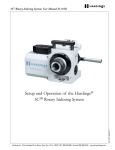

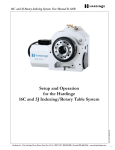
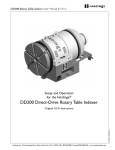
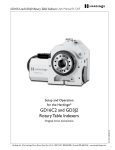
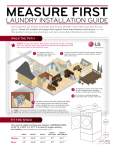
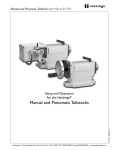
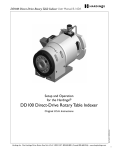
![PDF) [PDFファイル/151KB]](http://vs1.manualzilla.com/store/data/006545267_2-6d1fcab5e372e820429e43b715426a35-150x150.png)
